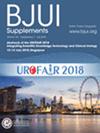Microwave vs radiofrequency ablation for small renal masses: perioperative and oncological outcomes
IF 3.7
2区 医学
Q1 UROLOGY & NEPHROLOGY
引用次数: 0
Abstract
ObjectiveTo conduct a comprehensive comparison of microwave ablation (MWA) vs radiofrequency ablation (RFA) outcomes in the treatment of small renal masses (SRMs), specifically: TRIFECTA ([i] complete ablation, [ii] absence of Clavien–Dindo Grade ≥III complications, and [iii] absence of ≥30% decrease in estimated glomerular filtration rate) achievement, operative time (OT), and local recurrence rate (LRR).Patients and MethodsWe retrospectively analysed 531 patients with SRMs (clinical T1a–b) treated with MWA or RFA at a single centre (2008–2022). First, multivariable logistic regression models were used for testing TRIFECTA achievement. Second, multivariable Poisson regression models were used to evaluate variables associated with longer OT. Finally, Kaplan–Meier plots depicted LRR over time. All analyses were repeated after 1:1 propensity score matching (PSM).ResultsOf 531 patients with SRMs, 373/531 (70.2%) underwent MWA and 158/531 (29.8%) RFA. MWA demonstrated superior TRIFECTA achievement (314/373 [84.2%]) compared to RFA (114/158 [72.2%],微波与射频消融术治疗肾脏小肿块:围手术期和肿瘤学结果
目的对微波消融(MWA)与射频消融(RFA)治疗肾小肿块(SRM)的疗效进行综合比较,特别是:TRIFECTA([i]完全消融,[ii]无 Clavien-Dindo ≥III 级并发症,[iii]无估计肾小球滤过率下降≥30%)成就、手术时间 (OT) 和局部复发率 (LRR)。患者和方法我们回顾性分析了在一个中心接受 MWA 或 RFA 治疗的 531 例 SRM(临床 T1a-b)患者(2008-2022)。首先,使用多变量逻辑回归模型检验 TRIFECTA 的成就。其次,使用多变量泊松回归模型评估与更长 OT 相关的变量。最后,Kaplan-Meier 图描述了随着时间推移的 LRR。结果 在 531 例 SRM 患者中,373 例/531 例(70.2%)接受了 MWA 治疗,158 例/531 例(29.8%)接受了 RFA 治疗。与 RFA(114/158 [72.2%],P = 0.001)相比,MWA 的 TRIFECTA 成功率更高(314/373 [84.2%])。MWA与RFA治疗患者的完全消融率较高(348/373 [93.3%] vs 137/158 [86.7%],P = 0.001),从而导致了这些差异。在多变量逻辑回归模型中,MWA 与 RFA 相比,在 PSM 之前(赔率 [OR] 1.92,P = 0.008)和之后(OR 1.99,P = 0.023),MWA 与更高的 TRIFECTA 成效相关。最后,MWA 与 RFA 相比,中位手术时间更短(105 分钟与 115 分钟;P = 0.002)。在泊松回归分析中,MWA 预测 PSM 之前(发病率比 [IRR] 0.86,P <0.001)和之后(IRR 0.85,P <0.001)的 OT 更短。中位(四分位间)随访 24 (8-46) 个月后,17/373(4.6%)例 MWA 治疗患者和 21/158(13.3%)例 RFA 治疗患者出现局部复发(P = 0.29)。在 PSM 之前(P = 0.29)和之后(P = 0.42)的 Kaplan-Meier 图中,LRR 没有差异。结论与 RFA 相比,微波消融的 TRIFECTA 成效更高,OT 时间更短,但 LRR 没有明显差异。
本文章由计算机程序翻译,如有差异,请以英文原文为准。
求助全文
约1分钟内获得全文
求助全文
来源期刊

BJU International
医学-泌尿学与肾脏学
CiteScore
9.10
自引率
4.40%
发文量
262
审稿时长
1 months
期刊介绍:
BJUI is one of the most highly respected medical journals in the world, with a truly international range of published papers and appeal. Every issue gives invaluable practical information in the form of original articles, reviews, comments, surgical education articles, and translational science articles in the field of urology. BJUI employs topical sections, and is in full colour, making it easier to browse or search for something specific.
 求助内容:
求助内容: 应助结果提醒方式:
应助结果提醒方式:


